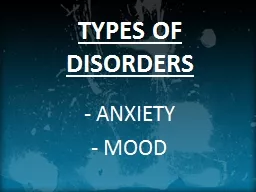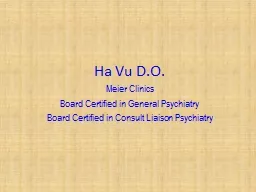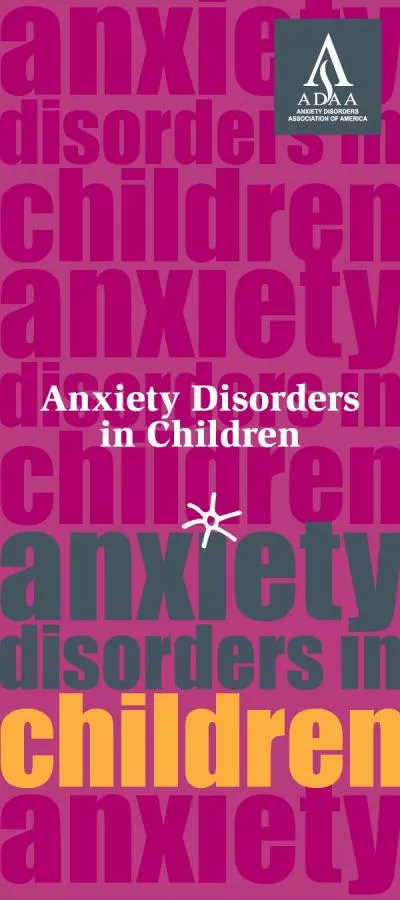PPT-Handling Anxiety and Low Mood
Author : felicity | Published Date : 2022-06-14
January 29 2021 Ed Fisher PhD Global Director Patrick Tang MPH Program Manager About Low Mood Strategies to improve low mood Practical Steps About Anxiety Strategies
Presentation Embed Code
Download Presentation
Download Presentation The PPT/PDF document "Handling Anxiety and Low Mood" is the property of its rightful owner. Permission is granted to download and print the materials on this website for personal, non-commercial use only, and to display it on your personal computer provided you do not modify the materials and that you retain all copyright notices contained in the materials. By downloading content from our website, you accept the terms of this agreement.
Handling Anxiety and Low Mood: Transcript
January 29 2021 Ed Fisher PhD Global Director Patrick Tang MPH Program Manager About Low Mood Strategies to improve low mood Practical Steps About Anxiety Strategies to reduce anxiety Practical Steps. Fact 1 Anxiety is a normal and adaptive system in the body that tells us when we are in danger Therefore dealing with your anxiety NEVER involves eliminating it but rather managing it Fact 2 Anxiety becomes a problem when our body tells us that ther 11 3266 2453 4819 3483 4819 3483 3604 3604 Anthem Dentegra Dentegra Family Plan Type High Low High Low Low High Low High Low High Low Low Low Diagnostic Preventive DP 100 80 100 100 100 100 100 100 100 100 100 100 100 Basic Services 75 60 80 50 60 8 Sherlene T. Dean APRN. University of Utah HOME program. Matt’s Place. Components. of a Psychiatric Evaluation. History of Present Illness. Determine the diagnoses. Previous Psychiatric History. Social History. What is abnormal behavior?. Deviance – atypical from what is normal. Maladaptive Behavior – everyday adaptive behavior is impaired. Personal Distress – usually depression, anxiety disorders. Once Upon A Time. What is the tone? Mood?. Tone and Mood. What is the tone? Mood?. Tone and Mood. What is the tone? Mood?. What is the tone? Mood?. What is the tone? Mood?. What is the tone? Mood?. What is the tone? Mood?. is the overall feelings or emotions that are created IN THE READER. . The . “power of the pen” can move mountains. . Authors . “move” their readers’ moods through their choice of words and level of detail.. A natural, normal feeling that we all experience from time to time.. Our body’s way of preparing ourselves for a challenge when faced with stress, by releasing a chemical called adrenaline. Causes a ‘. Mood/Tone MOOD MOOD is the overall feelings or emotions that are created IN THE READER . -The “power of the pen” can move mountains. Authors “move” their readers’ moods through their The Low Carb Weight Loss Secrets Box Set INCLUDES 50+ MUST try Recipes that will leave your tastebuds tingling with EXCITEMENT!!Now you can get the bestselling books Low Carb Recipes That Are Irresistibly Tasty and Low Carb Weight Loss Secrets for a discounted price of $3.99! This box set includes: Low Carb Diet For Weight Loss Secrets-How To Effortlessly Lose Weight Fast With The Low Carb Diet This book expounds on the low carb diet and introduces several weight loss secrets as well as strategies and tips on how to successfully implement the low carb diet in your life. There is a high chance that you\'ve already tried a ton of different diet plans and weight loss strategies that simply didn\'t lead to the desired weight loss effect or you just lost the weight only to gain it all back. Chances are you\'ve tried your best, but the techniques simply didn\'t work. If this is the case, you don’t have to worry. This book will not only give you the information you need to know about the low carb diet and its amazing benefits, but also will provide you with a few easy strategies and tips on how to effortlessly get rid of the few excess pounds. You will be happy to know that the low carb diet is quite different from other diets. It has been proven by various scientific sources that the low carb diet is extremely beneficial to your health. However, this is not even the best part. What’s great about the low carb diet is that it requires little to no excess work. This doesn\'t mean that there aren’t challenges that arise from the implementation of the low carb diet. As with any other diet or life-changing plan, you will have to face certain restrictions, which may be a bit too much for your willpower. However, this book will provide you with a few low carb diet weight loss secrets, tips and strategies to help you easily deal with any challenge that arises from the restrictions of the diet. and... 50 Delicious and Easy to Make Low Carb Recipes for your Health and Weight Lost Needs Here Is A Preview Of What You\'ll Gain From This Book: 10 Low Carb Breakfast Recipes 10 Low Carb Lunch and Dinner Recipes 10 Low Carb Side Dish Recipes 10 Low Carb Snack Recipes 10 Low Carb Dessert Recipes Free Preview of a Best Seller in the Low Carb Category Download the Low Carb Weight Loss Secrets Box Set right now... MOOD. TODAY’S OBJECTIVES. Identify the behavioral patterns that psychologists label as anxiety disorders.. Explain what causes anxiety disorders.. Describe several theories that try to explain mood disorders. . Board Certified in General Psychiatry. Board Certified in Consult Liaison Psychiatry. Disclosure. I, Ha VU, do not have relationship(s) with commercial interests.. Horror Stories of Antidepressants. Anxiety disorders areThey are characterized by persistent, irrational, and overwhelming worry, fear, and anxiety that interfere with daily activities. These are real disorders that affect how the brai Bell . Ringer. :. When you think of the word. . home. what images come to mind? What other words come to mind?. Connotation & Denotation. Define. Connotation/Denotation of Animals. Connotation/Denotation of Sports Teams. . Dr. Sonalika’s Eye Clinic provide the best Low vision aids treatment in Pune, Hadapsar, Amanora, Magarpatta, Mundhwa, Kharadi Rd, Viman Nagar, Wagholi, and Wadgaon Sheri
Download Document
Here is the link to download the presentation.
"Handling Anxiety and Low Mood"The content belongs to its owner. You may download and print it for personal use, without modification, and keep all copyright notices. By downloading, you agree to these terms.
Related Documents



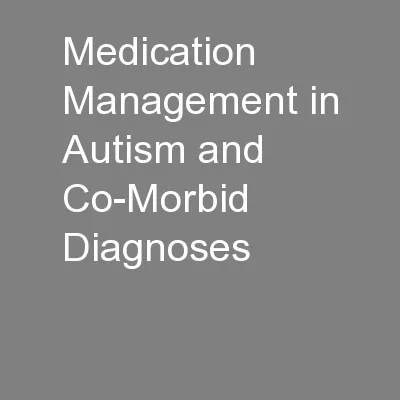



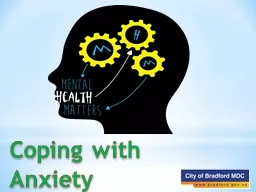

![[READ] Low Carb: Low Carb Weight Loss Secrets Box Set (Dash Diet, Slow Cooker Meals, Low](https://thumbs.docslides.com/881235/read-low-carb-low-carb-weight-loss-secrets-box-set-dash-diet-slow-cooker-meals-low-carb-cookbook-low-carb-recipes-low-car.jpg)
